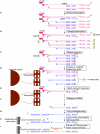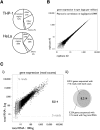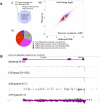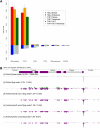Unamplified cap analysis of gene expression on a single-molecule sequencer
- PMID: 21596820
- PMCID: PMC3129257
- DOI: 10.1101/gr.115469.110
Unamplified cap analysis of gene expression on a single-molecule sequencer
Abstract
We report the development of a simplified cap analysis of gene expression (CAGE) protocol adapted for single-molecule sequencers that avoids second strand synthesis, ligation, digestion, and PCR. HeliScopeCAGE directly sequences the 3' end of cap trapped first-strand cDNAs. As with previous versions of CAGE, we better define transcription start sites (TSS) than known models, identify novel regions of transcription and alternative promoters, and find two major classes of TSS signal, sharp peaks and broad regions. However, using this protocol, we observe reproducible evidence of regulation at the much finer level of individual TSS positions. The libraries are quantitative over 5 orders of magnitude and highly reproducible (Pearson's correlation coefficient of 0.987). We have also scaled down the sample requirement to 5 μg of total RNA for a standard HeliScopeCAGE library and 100 ng for a low-quantity version. When the same RNA was run as 5-μg and 100-ng versions, the 100 ng was still able to detect expression for ∼60% of the 13,468 loci detected by a 5-μg library using the same threshold, allowing comparative analysis of even rare cell populations. Testing the protocol for differential gene expression measurements on triplicate HeLa and THP-1 samples, we find that the log fold change compared to Illumina microarray measurements is highly correlated (0.871). In addition, HeliScopeCAGE finds differential expression for thousands more loci including those with probes on the array. Finally, although the majority of tags are 5' associated, we also observe a low level of signal on exons that is useful for defining gene structures.
Figures





References
-
- Carninci P, Kasukawa T, Katayama S, Gough J, Frith MC, Maeda N, Oyama R, Ravasi T, Lenhard B, Wells C, et al. 2005. The transcriptional landscape of the mammalian genome. Science 309: 1559–1563 - PubMed
-
- Carninci P, Sandelin A, Lenhard B, Katayama S, Shimokawa K, Ponjavic J, Semple CA, Taylor MS, Engstrom PG, Frith MC, et al. 2006. Genome-wide analysis of mammalian promoter architecture and evolution. Nat Genet 38: 626–635 - PubMed
-
- Cloonan N, Forrest AR, Kolle G, Gardiner BB, Faulkner GJ, Brown MK, Taylor DF, Steptoe AL, Wani S, Bethel G, et al. 2008. Stem cell transcriptome profiling via massive-scale mRNA sequencing. Nat Methods 5: 613–619 - PubMed
-
- Faulkner GJ, Forrest AR, Chalk AM, Schroder K, Hayashizaki Y, Carninci P, Hume DA, Grimmond SM 2008. A rescue strategy for multimapping short sequence tags refines surveys of transcriptional activity by CAGE. Genomics 91: 281–288 - PubMed
Publication types
MeSH terms
Substances
Associated data
- Actions
LinkOut - more resources
Full Text Sources
Other Literature Sources
Molecular Biology Databases
Research Materials
Miscellaneous
